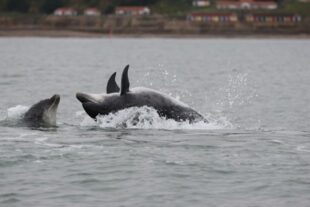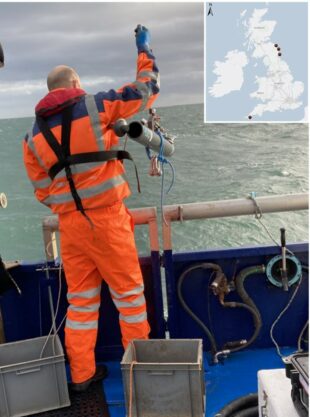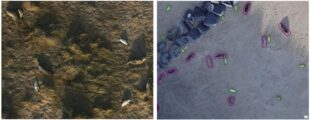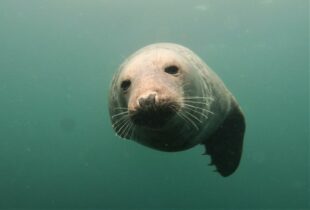By Samantha Parker and Emma Milner, Natural England marine mammal senior specialists
Why are seal population numbers changing so fast along our coasts? How are porpoise feeding patterns changing as our seas become increasingly crowded? And how does the health of our dolphin populations relate to human wellbeing?
These are all questions to which we don’t yet have answers, but an integrated evidence collection project by Natural England has been working hard on improving our knowledge about marine mammals in the last 3 years, testing new methods for monitoring species including dolphins, porpoises and seals. It’s part of a wider effort to discover more about the species and habitats found in our waters, and will eventually feed into new monitoring recommendations for our inshore waters including, but not limited to, Marine Protected Areas (MPAs).

The work is being undertaken by Natural England staff as part of the Defra-funded marine Natural Capital and Ecosystem Assessment (NCEA). Natural capital describes the parts of our environment that have value to people – like healthy seas which support food production, or saltmarshes which help buffer coastlines against storm surges.
NCEA is Defra’s flagship research and development programme, and a major driver of new research to improve how we monitor the marine environment. Alongside better monitoring, the programme is designing the tools and structures we need to slot natural capital approaches into decision-making at different levels and in different places.
Streamlining monitoring processes and management tools so that they work effectively together is especially important at the moment – there are huge pressures on our marine spaces, and the prospect of more to come, but we also have ambitious targets for marine recovery and a will for action at both national and international levels.

For marine mammals, as for other groups, it’s important to make sure that we’re collecting the right evidence, using the right methods, in the right places. Three years ago, specialists joined the mNCEA programme and began reviewing what evidence existed for marine mammals that could be made available for natural capital assessments. The review identified a need for more ecological data, more data on the ways these wide-ranging, highly mobile species help to maintain and regulate a stable marine environment, and more information on their cultural value to society.
Our current main sources of data on cetaceans (whales, dolphins, porpoises) in UK seas are international coordinated surveys funded by governments and staffed largely by volunteers. Citizen science organisation Sea Watch coordinates casual land-based sightings, while ORCA organises volunteer surveys along commercial ferry routes. However, we still lack detailed data for our inshore waters (within 12 nautical miles of shore). mNCEA is therefore investigating additional methods to help us create a picture that encompasses all our seas, from coast to continental shelf.
In this first year, we started a multi-year acoustic monitoring project using hydrophones (underwater microphones). These were placed in the waters off the north-east coast of England to record the clicks which dolphins and porpoises use to locate each other and their prey. This data tells us about where these mammals spend time, and what their feeding patterns are.
In the second year, work began on filling the knowledge gaps for cultural ecosystem services provided by marine mammals. Our economists asked the public to give their opinion on how much they were willing to pay (or, conversely, would need to be paid) for different scenarios in which populations of specific species increased or decreased by different amounts.
One of our findings has been that the public is willing to pay not just to protect specific species like bottlenose dolphin, but also to deliver complex policy goals like achieving Good Environmental Status in UK seas, which would bring improvements to the whole seascape.

We’ve also embarked on a three-year long investigation into environmental DNA (eDNA) methods and what these can tell us about marine mammals. eDNA is DNA lost into the environment by animals and other organisms – for example, through skin cells, mucus, and faeces. When seawater is collected this can be filtered and analysed to show what animals have been recently present. This is a new technology, and we’re still working out how best to incorporate it into our armoury of monitoring techniques.
In yet another study, we’ve used Artificial Intelligence (AI) to analyse aerial and drone imagery of seal colonies, training models to identify and count adults and pups. We’re now hoping to apply AI techniques to satellite imagery, to identify pressures from recreational and commercial boats in marine protected areas designated for seals.

In year three (2024-25) a partnership was established with the Sea Mammal Research Unit (SMRU) at St Andrews University to assist in filling evidence gaps relating to ‘nutrient cycling’ - the role marine mammal poo plays in regulating and maintaining wider ecosystems.
The project scientists are looking at the faeces of harbour seals, grey seals, bottlenose dolphins and harbour porpoise to see what nutrients they expel into the environment. Mammal poo provides essential nutrients used by phytoplankton (microscopic marine algae), which sit at the base of the marine food web.
Through the same partnership, SMRU are also providing evidence on the bottlenose dolphins off the east coast of England using Photo-ID surveys. This data will be matched to catalogues in Scotland to see whether the English dolphins are visitors from protected Scottish populations, or a separate population.
Data from all these innovative projects will contribute to our knowledge of the habits and locations of marine mammals across inshore English waters, as well as helping us to measure the ecosystem services they provide to people.
Reports and data will be made publicly available under Open Government License on the Natural England Access to Evidence website and the Defra repository.

Contributors to this blog: Samantha Parker and Emma Milner, marine mammal senior specialists; Dylan Todd, marine ecologist, Elizabeth Mitchell, engagement senior specialist, all marine Natural Capital and Ecosystem Assessment programme.